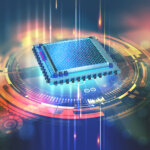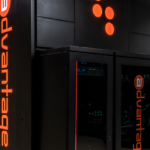Quantum computing explained

|
Getting your Trinity Audio player ready...
|
We’re hearing a lot about quantum computing these days – but what, actually, is it? Well, quantum computing is often explained as computing that uses the principles of quantum physics…
Any the wiser?
Quantum physics, for the purposes of explaining the theory behind quantum computing, includes two crucial elements – quantum superposition, and quantum entanglement.
Dive into the mechanics.
The whole deal with quantum physics is that it’s the physics that deals with the behavior of incredibly small things and the forces that work on them (often in different ways to the ways we’d expect in standard, observed physics) – like for instance the spin of an electron, or the orientation of a proton.
Quantum superposition is, in itself, a thing that boggles minds. It’s the ability of quantum systems to be in multiple states at the same time. The most popularly understood explanation of which is Schrodinger’s Cat, where an unobserved cat in a box can be thought of as both alive and dead at the same time, and only observation determines which reality gets to “exist.”
It’s worth noting that Schrodinger invented that thought experiment largely to explain how absurd quantum physics was, but in terms of quantum computing, it’s a reasonable way of thinking about quantum superposition. Yes and no, black and white, alive and dead – pick a duality, any duality you like. Quantum superposition, dealing with tiny particles and forces, means they can both be simultaneously equally true until observed – and that has significant benefits in terms of computational speed compared to standard computers.
Quantum entanglement is an odd state where, for instance, two particles exist in such a way that their quantum state can’t be properly described without reference to one another – whether they’re physically close to one another or not.
We know.
Take a drink of water, take a lie down in a dark room, and come back, because there’s more – and it’s important for the future of computing.
One giant leap…
The mechanics of these two elements of quantum physics, quantum superposition and quantum entanglement, do very weird things to the way we think about numbers at an atomic level – and they also do incredible things to the speed at which computations can actually be made.
Why is that?
In standard computers, even the most modern ones we can build, the standard unit of encoding is the “bit” – the 0s and 1s of a binary system. With 8 bits, a standard computer can represent any number you need, between 0 and 255.
Quantum computers are free from such binary constraints. Their fundamental unit of encoding is the quantum bit, or more usually qubit. Qubits relate to those physical quantum systems, like electron spin or proton orientation. What that means in storage and calculation power is that while 8 bits can get you any single number between 0-255, 8 qubits can get you every number between 0-255 at the same time.
Couple that with quantum entanglement (which means a sequence of qubits can represent multiple distinct things at the same time), and you have a frankly insane leap in storage and processing power.
Just as an example, it currently takes between 2-4 GB to store or stream a single, average-length HD movie. A single GB is equivalent to a billion bytes, and a byte is made up of 8 bits. So to stream or store the latest Marvel movie, you’re looking at something in the region of 16-32… billion bits.
Crunching the universe.
By comparison, the New Scientist helpfully tells us that “A few hundred entangled qubits would be enough to represent more numbers than there are atoms in the universe.”
That right there is the big difference between standard computers as we’ve known them since they became ubiquitous in the late Eighties and early Nineties, and quantum computing.
Quantum computers will store vast amounts of data in much smaller “spaces,” but more than that, the combination of quantum superposition and quantum entanglement will mean quantum computing leads to computers that aren’t just radically faster when it comes to both complex and iterative computations, they’re faster in a way we’ve barely dared imagine before.
In particular, complex and iterative mathematical problems will be soluble much faster. Mathematical models of the universe? No problem. Modeling seriously complex things, like cities or financial markets? Quantum’s a go-to. In particular of course, advanced AI and machine learning technology, to solve everything from capitalism to dread disease – quantum computing will empower the human race in a staggering range of new ways.
The Cybersecurity conundrum.
Unfortunately of course, its ability to crack insanely complex mathematical or iterative puzzles in a handful of electronic heartbeats also carries a problem with it – in that most traditional cybersecurity is based on building ever more uncrackable mathematical or iterative puzzles.
Most of those are based on the capabilities of standard computers, which, for instance, would take far too long to crack cybersecurity without triggering all sorts of inconvenient alarms and security teams.
Quantum computing will more or less treat such systems and cybersecurity with the contempt they will deserve, with its significantly more rapid processing speeds – leading to an industry-wide push to adopt post-quantum cryptographic standards (which thankfully already exist). That potentially in-built threat to traditional security though is also becoming a significant driver towards the development and deployment of so-called “biocomputers” – which are a whole different ball game again.
Quantum computing will transform the world in a whole array of ways – some of which we can currently understand, and others of which are as yet beyond our horizon. Certainly, as we explained, its powering of more and more advanced AI and machine learning will deliver several improvements currently thought of as pure science fiction, because the combination of the sheer speed and power unlocked by quantum computing, coupled with machine learning capabilities, pattern recognition, and data crunching is likely to be as significant as the first deployment of home and office computers was to our understanding of what work and life looked like – and would look like in the future.
We just have to make sure we have post-quantum cryptography methods deployed, so that it’s a safe revolution in computing power to have, and so our whole notion of cybersecurity doesn’t implode, relatively overnight.










